The 2023-24 Premier League season was, well, kind of a weird one.
While there was a three-team title race for most of the season, it ended the same way it always does: with Manchester City on top of the table. City won for the fourth year running and sixth in the past seven.
The relegation battle was almost nonexistent, as the three most recently promoted teams combined to win 14 matches, lose 76 and sink back to the second division.
And on weekdays, the league underachieved in UEFA competitions, failing to secure an extra spot in the newly expanded Champions League. Not a single English club reached the semifinals of either the Champions League or the Europa League. The hyper-capitalist Premier League is supposed to be the most competitive league in the world, but it wasn’t — at home or abroad.
As always, there was plenty of off-field drama, though. Much of the day-to-day yelling was saved for issues such as point deductions (Everton lost eight points, Nottingham Forest six), profit and sustainability rules, Manchester City’s looming legal fight over 115 allegations of financial breaches and, of course, efforts to get rid of VAR.
But that was last season. Every season takes on its own set of vibes, and 2024-25 should produce something completely different. The season begins on Friday, so it’s time for Bill Connelly and Ryan O’Hanlon to fill you in on what you need to know. They’ve once again teamed up to preview all 20 teams and predict the finishing positions of every club, 1 through 20 (as much as it is possible to do so in a universe with point deductions). The rankings are the averages of Bill and Ryan’s combined predictions.
(Note: All transfer values come from Transfermarkt.)
 1T. Arsenal
1T. Arsenal
– Last season’s finish: 2nd (89 points, plus-62 goal differential)
– Key ins: CB Riccardo Calafiori (Bologna, €45m), GK David Raya (Brentford, €31.9m)
– Key outs: AM Emile Smith Rowe (Fulham, €31.8m)
Key stat
Only two teams in the Premier League were younger than Arsenal last season. Weighted by minutes played, the average age of Mikel Arteta’s team was 25.0 — just a bit older than Burnley (24.5) and Chelsea (24.2). Most title-contending teams, filled with prime-age players and established 30-something stars, sit closer to 27.
What does it all mean? While top-of-the-table sides usually need outside reinforcements just to ensure they won’t experience an age-related decline, the Gunners could simply improve because their players improve.
One big question: Can Arsenal generate enough quality chances to win the league?
Arsenal’s transformation into one of the best teams in the world has been driven more by defense than offense. Last year, they allowed a league-low 29 goals — five fewer than anyone else — and that came from an expected goal (xG)-conceded total even lower than that. This defense is legit, and it’s one of the best we’ve seen in a long time. But while they did score 82 nonpenalty goals last season, that massively outpaced their xG tally of 69.6, which ranked fourth in the league.
They generate plenty of chances. The problem is not many of them are high-quality. Cribbing off the work of analysts Jamon Moore and Carlon Carpenter, we can divide shots into four buckets — poor, average, good and great — based on their xG value. “Great shots” are those with an xG of 0.33 or higher. Here’s how the league ranked by that metric last season:
 There’s a fascinating question of the push-and-pull between Arsenal’s defense and its attack: Is the defense as good as it is because there’s a limit on how good the attack can be? Or can the defense maintain its level while the attack potentially improves? If it’s the latter, Arsenal will win the league. — O’Hanlon
There’s a fascinating question of the push-and-pull between Arsenal’s defense and its attack: Is the defense as good as it is because there’s a limit on how good the attack can be? Or can the defense maintain its level while the attack potentially improves? If it’s the latter, Arsenal will win the league. — O’Hanlon
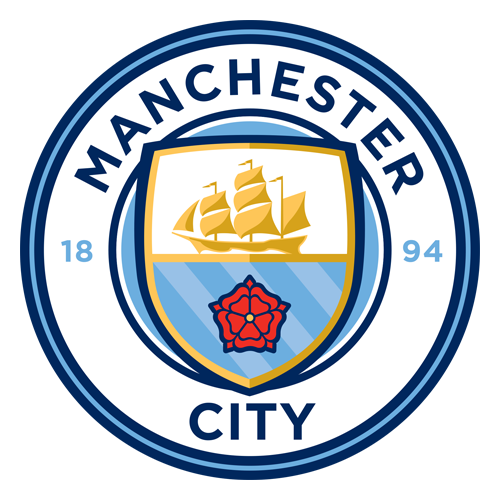 1T. Manchester City
1T. Manchester City
– Last season’s finish: 1st (91 points, plus-62 goal differential)
– Key ins: RW Sávio (Troyes, €25m)
– Key outs: CF Julián Álvarez (Atlético Madrid, €75m)
Key stat
City led the league in basically every category you would expect them to lead last season: possession rate (65.2%), total touches, total passes, progressive passes, progressive carries, assists, buildup attacks (sequences with 10 or more passes that end with a shot or a box touch), shots against and more. Even as they evolve and adapt, you always know that you’re watching a Pep Guardiola team.
One big question: Is this Man City’s last dance with Guardiola or not?
On the pitch, City have remained the league’s gold standard. They went unbeaten in their final 23 league matches to outlast Arsenal for yet another title, and they won despite getting only 1,227 minutes from Kevin De Bruyne and a below-average finishing campaign from Erling Haaland (27 goals from shots worth 29.7 xG). Phil Foden combined 19 goals with eight assists, six players finished at eight to 10 assists, and defensive midfielder Rodri continued his magic: City have gone unbeaten in 50 straight Premier League matches with him in the lineup.
City barely even made any moves this season, adding only Savio from City Group sister club Troyes (after his breakout season on loan with City Group sister club Girona), and he was one of seven 22-and-under players who contributed to their penalty shootout win over Manchester United in the Community Shield.
They are on cruise control, and there’s no reason to think more than one team, Arsenal, could seriously challenge them in 2024-25.
So instead, when we talk about City, we end up talking more about the future. Their battle against 115 alleged finance breaches will finally begin soon, and Guardiola’s contract expires in 2025. He has given conflicting signs regarding whether he’ll sign an extension. (It’s easy to assume his decision will be influenced by the sanctions City might or might not receive.)
This could be the denouement of the Guardiola era, or it could simply be another year of dominance in a long period of dominance. Regardless, it’s hard to start this list with any other team. — Connelly
 3. Liverpool
3. Liverpool
– Last season’s finish: 3rd (82 points, plus-45 goal differential)
– Key ins: None
– Key outs: AM Fábio Carvalho (Brentford, €32m), CM Thiago Alcantara (retired), CB Joel Matip (contract expired)
Key stat
No team outside of their own city had a worse finishing season than Liverpool last year. While Manchester City (plus-13.5) and Arsenal (plus-9.9) led the league in xG overperformance in 2023-24, only Everton (minus-14) underperformed their shot quality by a bigger degree than Jurgen Klopp’s side did (minus-7.8). Each member of the front three ranked in the bottom 10 for efficiency in front of goal: Mohamed Salah (minus-3.2, eighth), Luis Díaz (minus-3.9, fifth), and, you guessed it, Darwin Núñez (minus-5.3, second).
One big question: Can Arne Slot keep this thing going in the right direction?
The common refrain from Liverpool’s new manager this summer has been: Have you seen the talent in my squad? Please stop asking me about transfers. No one expected Liverpool to be title challengers last season, and if they were a little more efficient in front of goal in the spring or avoided an injury crisis, outgoing manager Klopp probably would have gone out on top.
Was that performance the result of a kind of teamwide ”Last Dance” mentality — a collective emotional thrust that almost got a less-talented team beyond Arsenal and Manchester City? Or was it the result of some regression to the mean — surely, they were better than the sixth-place finish in 2022-23 — and a midfield revamp?
For a few days there, it seemed likely that Real Sociedad midfielder Martín Zubimendi would finally end the club’s two-year-long search for a holding midfielder. The choice of the 25-year-old — more controller than destroyer — seems to signify a slight shift in approach from the Klopp era toward more patience with the ball. The move ultimately fell apart — apparently the gray skies of Liverpool can’t compete with the mountains of San Sebastian — and I wouldn’t read too much into what it all means.
Slot’s teams still look like the Phoenix Suns’ “Seven Seconds or Less” offense compared to Arsenal and City. But will a minor tweak in tactics perhaps make Liverpool more defensively sound, less prone to injury and potentially better than last year? Or was the vertical mania of last season actually the optimal way for this group of players to play? — O’Hanlon
Frank Leboeuf says that Liverpool have every chance of winning the Premier League under Arne Slot this season.
 4. Chelsea
4. Chelsea
– Last season’s finish: 6th (63 points, plus-14 goal differential)
– Key ins: RW Pedro Neto (Wolves, €60m), CM Kiernan Dewsbury-Hall (Leicester City, €35.4m), GK Filip Jörgensen (Villarreal, €24.5m), AM Omari Kellyman (Aston Villa, €22.5m), DM Renato Veiga (Basel, €14m), CF Marc Guiu (Barcelona, €6m), CB Tosin Adarabioyo (Fulham, free)
– Key outs: LB Ian Maatsen (Aston Villa, €44.5m), LB Lewis Hall (Newcastle, €33m), RW Omari Hutchinson (Ipswich (€23.5m), CB Thiago Silva (Fluminense, free), RW Hakim Ziyech (Galatasaray, free)
Key stat
From Christmas onward, Chelsea ranked fourth in the league in both points per game (2.05) and goal differential (plus-13). They played at a Champions League pace for more than half the season. Then they parted ways with coach Mauricio Pochettino and added almost an entire lineup’s worth of new players.
One big question: When will Chelsea’s assets become a team?
Arsenal lists 24 players as part of the first team; Manchester City is at 28, and 14 of 20 Premier League teams are at 30 or lower. Chelsea are at 42. They are addicted to acquiring players.
Thirty-six players saw action in 2023-24, they’ve added more than they have sent away this offseason, and they’re clearly not done yet. But while we don’t know what Chelsea’s roster will look like on Aug. 31, at the moment manager Enzo Maresca has a treasure trove of fun (and mostly young) attackers — Cole Palmer, Christopher Nkunku, Nicolas Jackson, the less-young Raheem Sterling, summer friendlies star Noni Madueke and now Pedro Neto for some reason.
Maresca will have most of last year’s defense, too, though we’ll see if that’s a good thing: Chelsea ranked 12th in goals allowed and 13th in shots allowed per possession. Regardless, there’s a good team somewhere in here if Maresca can sift through all the extra players to find it. — Connelly
 5. Newcastle United
5. Newcastle United
– Last season’s finish: 7th (60 points, plus-23 goal differential)
– Key ins: LB Lewis Hall (Chelsea, €33m), GK Odysseas Vlachodimos (Nottingham Forest, €23.6m), CF William Osula (Sheffield United, €11.6m), CB Lloyd Kelly (Bournemouth, free)
– Key outs: CM Elliot Anderson (Nottingham Forest, €41.2m), RW Yankuba Minteh (Brighton, €35m)
Key stat
Two seasons ago, Newcastle allowed 33 goals, which tied for fewest in the league with Manchester City. Last season, Newcastle allowed 62 goals, which tied for 10th fewest in the league with Brighton. It wasn’t just bad luck, either, as Eddie Howe’s side conceded 61.4 xG. For a team that played in the Champions League, this was one of the worst defenses we’ve seen in a long time.
One big question: How much of last season’s struggles were due to injuries?
In this chart, which plots each five-game average for Newcastle’s xG conceded across the entire season, see if you can spot where their season completely imploded:

It’s easy to draw a simple story from that. Newcastle surprised everyone by finishing fourth in 2022-23. They were ahead of schedule after the Saudi PIF takeover, and so that meant a team that hadn’t been in the Champions League group stages in more than 20 years was taking a squad that wasn’t quite big enough to compete on multiple fronts into the Champions League group stages, and they were being managed by a coach, Eddie Howe, with precisely zero previous games of Champions League experience. If a team was ever going to buckle under the weight of extra competitive matches, it was Newcastle last year. The extra matches around the holidays were the final blow.
The prior year, Newcastle relied on 10 players to appear in at least 70% of league minutes. Last season, just five broke the 70% barrier. And so, if injuries are to blame for the decline in performance, then there’s plenty of reason to believe that Newcastle will have a bounce-back season now that they’re out of the Champions League. If not? It might be a long time before Howe is managing another team playing on Tuesday and Wednesday nights. — O’Hanlon
 6. Tottenham Hotspur
6. Tottenham Hotspur
– Last season’s finish: 5th (66 points, plus-13 goal differential)
– Key ins: CF Dominic Solanke (Bournemouth, €66.5m), CM Archie Gray (Leeds United, €41.3m), CM Lucas Bergvall (Djurgarden, €10m), RW Yang Min-hyuk (Gangwon FC, €4m)
– Key outs: RB Emerson Royal (AC Milan, €15m), CB Joe Rodon (Leeds United, €11.8m), CB Eric Dier (Bayern Munich, free), DM Pierre-Emile Højbjerg (Marseille, loan)
Key stat
Spurs allowed just 8.8 passes per defensive action (PPDA, a common measurement of defensive intensity), the lowest in the league. In Ange Postecoglou’s first season leading Spurs, the team hit all the possession-and-pressing notes, right down to giving up a few too many high-quality counterattacks.

One big question: Is there more nuance for Spurs in Year 2?
“It’s just who we are, mate. As long as I’m here, that’s what we’re going to do.” That’s what Postecoglou said after a 4-1 November loss to Chelsea, in which two Spurs were sent off and they continued to press high (and get burned) regardless.
In Year 1, the goal was to establish an identity, and Postecoglou did it even though it meant occasional exhausted funks, the highest average xG allowed per shot in the league and only eight points in 11 matches against the rest of the Premier League’s top six. But in Year 2, everyone is familiar with each other, and recent additions give them better depth in both attack and midfield.
Does that make them a little more well-rounded and a little less predictable against better opposition? And how does Solanke, who scored 19 goals for a vertical Bournemouth attack, fit in with Son Heung-min, James Maddison, Brennan Johnson, Dejan Kulusevski & Co. up front? — Connelly
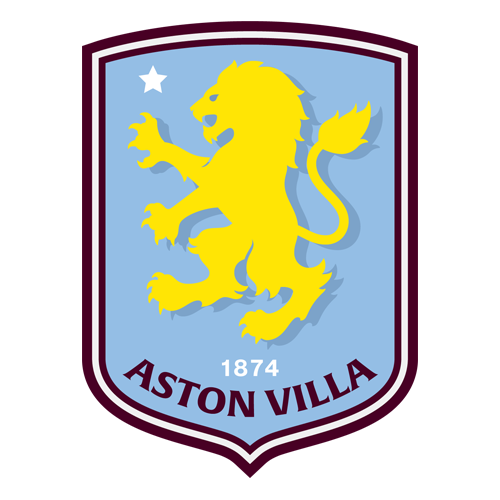 7. Aston Villa
7. Aston Villa
– Last season’s finish: 4th (68 points, plus-15 goal differential)
– Key ins: DM Amadou Onana (Everton, €59.35m), LB Ian Maatsen (Chelsea, €44.5m), CF Cameron Archer (Sheffield United, €16.65m), LW Jaden Philogene (Hull City, €16m), LW Samuel Iling-Junior (Juventus, €14m), DM Enzo Barrenechea (Juventus, €8m), CM Ross Barkley (Luton Town, €5.9m)
– Key outs: RW Moussa Diaby (Al Ittihad, €60m), CM Douglas Luiz (Juventus, €51.5m), CM Tim Iroegbunam (Everton, €10.7m), CM Morgan Sanson (Nice, €4m), CB Calum Chambers (Cardiff City, free)
Key stat
Take away penalties, and Ollie Watkins was the most productive attacker in the Premier League last year. Though he is no one’s usual idea of a creative player, he led the league in assists with 13, and only Haaland scored more nonpenalty goals than his 19. Add them together, and Watkins scored or assisted on 32. The gap between Watkins and second-best Foden (27) was as big as the gap between Foden and West Ham’s Jarrod Bowen in seventh.
One big question: Can they stave off regression?
Villa finished fourth without many of the trappings of a fourth-place team. They had the fifth-best goal differential and the seventh-best xG differential. My favorite marker of predictive team strength, though, is a blend of the two — 70% xG, 30% G — and by that Villa were either the sixth- or seventh-best team, with nearly identical numbers to Tottenham. Both Newcastle and Chelsea (fourth and fifth, respectively) were more than twice as good as Villa by this metric.
On top of that: they are in the Champions League! Although they’ve won the European Cup before (in 1982), the club has not been in the competition since the rebrand in the early 1990s. Will they be able to compete on multiple fronts? More often than not, when an upstart club qualifies for the Champions League for the first time in a long time, its performance falls off in the Premier League, buckling under the load of extra matches. See: Newcastle, last season.
However, Villa seem to be aware of this, as they’ve given Chelsea a run for their money in terms of the number of players added this summer. Plus, Unai Emery, unlike Howe, has a long history of managing clubs in multiple competitions. Unfortunately for Villa, though, their underlying performance could very easily improve next season — and still lead to a finish somewhere lower down the table. — O’Hanlon
 8. Manchester United
8. Manchester United
– Last season’s finish: 8th (60 points, minus-1 goal differential)
– Key ins: CB Leny Yoro (Lille, €62m), CF Joshua Zirkzee (€42.5m), CB Matthijs de Ligt (Bayern Munich, €45m), RB Noussair Mazraoui (Bayern Munich, €15m)
– Key outs: RW Mason Greenwood (Marseille, €26m), RB Aaron Wan Bissaka (West Ham, €17.6m), CB Willy Kambwala (Villarreal, €10m), CM Donny van de Beek (Girona, €500k), CB Raphaël Varane (Como, free), CF Anthony Martial (no club), DM Sofyan Amrabat (Fiorentina, end of loan)
Key stat
Manchester United allowed opponents to attempt 667 shots in 2023-24, second most in the Premier League. Not a ton of these shots were of high value, but the pure volume helped to create the league’s sixth-worst xG differential. They were lucky to finish even eighth in the league.
One big question: Was United’s defensive overhaul enough?
United’s problems began well before the ball got to the defense. The attack was extremely average (ninth in goals), as was the pressure (ninth in high turnovers forced), and the buildup game was awful (third-most high turnovers committed).
Defensive personnel indeed needed addressing. They basically traded Bissaka for Mazraoui at right-back and added De Ligt and Yoro. De Ligt has experience both with manager Erik ten Hag (at Ajax) and in a system with sturdy buildup play, and Yoro’s passing is strong for an 18-year-old, though he suffered an injury in preseason.
Adding Zirkzee could help as much with pressing as with scoring, and if the Community Shield is any indication, defensive midfielder Casemiro might be ready for a bounce-back season after a dreadful 2023-24. We’ll see if that’s enough to push United back up the table. — Connelly
Don Hutchison and Frank Leboeuf discuss Manchester United’s decision to keep Erik ten Hag.
 9. Brighton & Hove Albion
9. Brighton & Hove Albion
– Last season’s finish: 11th (48 points, minus-7 goal differential)
– Key ins: RW Yankuba Minteh (Newcastle, €35m), DM Mats Wieffer (Feyenoord, €30m), LW Ibrahim Osman (Nordsjaelland, €19.5m), CM Malick Yalcouye (Goteborg, €7m), RW Amario Cozier-Duberry (Arsenal, free)
– Key outs: CF Deniz Undav (Stuttgart, €26.7m), CM Pascal Gross (Borussia Dortmund, €7m), AM Adam Lallana (Southampton, free), AM Facundo Buonanotte (Leicester City, loan)
Key stat
Guess how many Brighton players scored double-digit goals last season? OK, fine, you’re right. The format of the question probably gave away the answer, which is “zero.” And if we remove penalties, it looks even worse: Simon Adingra and Evan Ferguson were the team’s leading scorers with six goals each.
One big question: Can the kids kick on?
Coming into last season, Ferguson and Julio Enciso looked like two of the best prospects in world soccer. The former was scoring and assisting goals at a near-elite rate — as a 17-year-old, in the most competitive league on the planet. The latter, meanwhile, put up similar goal+assists numbers to Ferguson, while playing deeper and doing a good deal more ball progression. What if they both made the leap at the same time? Would Brighton, too, finally leap into the Champions League places they’d just missed a year before?
Well, we never got to find out. Enciso got hurt and missed most of the season, while Ferguson struggled with an increased minutes load. However, progress is rarely linear, and Ferguson is still a teenager while Enciso is only 20. On top of their star potential, Brighton added the exciting 20-year-old Minteh from Newcastle, and they also have the likes of Adingra (22), Joao Pedro (22), Carlos Baleba (20), Jan Paul van Hecke (24), Bart Verbruggen (21), Tariq Lamptey (23) and Jack Hinshelwood (19).
Throw in the returns from injury for arguably their two best players, Kaoru Mitoma and Pervis Estupiñán, and there are a lot of paths toward immediate improvement under the new manager, 31-year-old Fabian Hurzeler. Yes, even their manager is ridiculously young now. — O’Hanlon
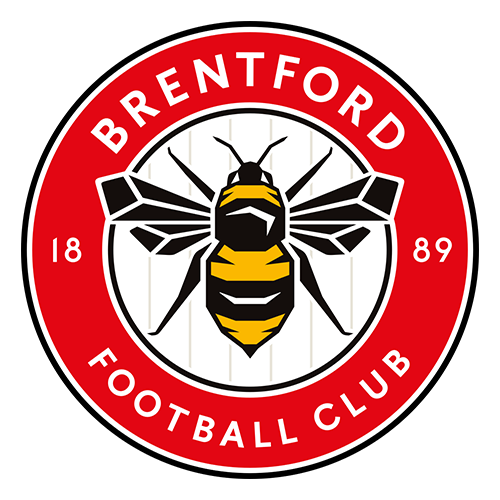 10. Brentford
10. Brentford
– Last season’s finish: 16th (39 points, minus-9 goal differential)
– Key ins: CF Igor Thiago (Club Brugge, €33m), AM Fábio Carvalho (Liverpool, €23.4m)
– Key outs: GK David Raya (Arsenal, €31.9m), CF Neal Maupay (Everton, end of loan)
Key stat
Brentford had the league’s highest percentage of shots in the box (73.2%) and allowed the second-lowest percentage (61.2%). They consistently win the shot quality battle, even if shot quantity doesn’t usually go their way.
One big question: Was it just bad luck?
After a delightful ninth-place finish in 2022-23, Thomas Frank’s Bees stumbled to 16th last season. They rallied in the spring to avoid relegation drama, but forward Ivan Toney accomplished very little (4 goals, 2 assists) after returning from his gambling suspension, and Brentford averaged a disastrous 0.78 of a point in games decided by 0-1 goal (3 wins, 9 draws, 11 losses).

On paper, Brentford were fine last season — they were eighth in xG differential, just as they were in 2022-23 — and we know that club owner Matthew Benham isn’t likely to panic when things look right on paper. Frank is returning, and the roster is mostly unchanged.
Transfer rumors have long swirled around Toney, but they’ve come to nothing, and with his potential replacement, Thiago, suffering a knee injury and likely missing the rest of 2024, it appears the England striker is now likely to stay. So, they’re running it back and hoping the bounces are kinder this time around. — Connelly
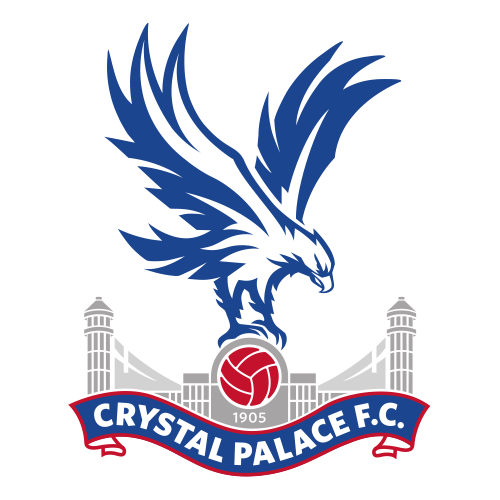 11. Crystal Palace
11. Crystal Palace
– Last season’s finish: 10th (49 points, minus-1 goal differential)
– Key ins: RW Ismaïla Sarr (Marseille, €15m), CB Chadi Riad (Real Betis, €15m), AM Daichi Kamada (Lazio, free)
– Key outs: RW Michael Olise (Bayern Munich, €53m)
Key stat
Only the top three teams in the Premier League won more points than Palace (24) after they replaced manager Roy Hodgson with Oliver Glasner on Feb. 19. And it was backed up by impressive underlying performance; they ranked sixth by the adjusted goal rating (70-30 xG-G blend) mentioned earlier:
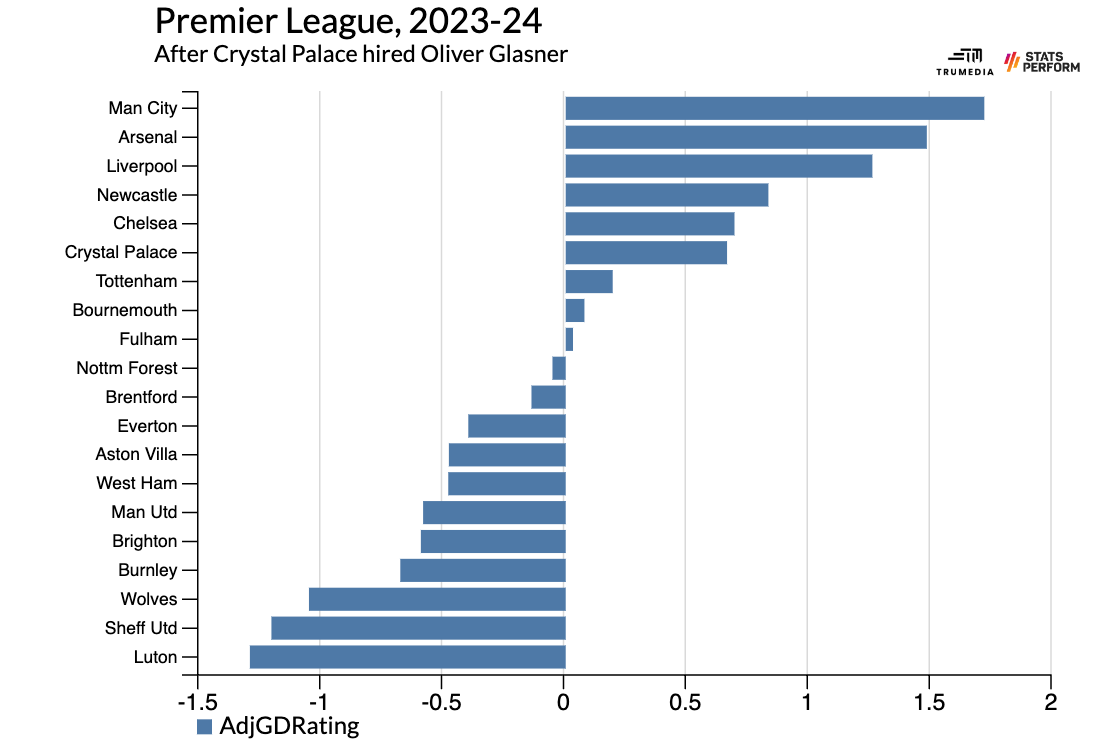
One big question: How much was 1,275 minutes of Olise worth?
I mean, we know the answer to that; Bayern Munich paid €53m to sign him. And in those minutes, Michael Olise was genuinely incredible. Like, best-player-in-the-league good. Per Michael Imburgio’s DAVIES model, which estimates a player’s value based on everything he does with the ball, Olise contributed 0.18 of a goal above the average player, per 90 minutes, at his position last season — a number matched only by Salah and bettered only by Núñez and Rodri.
Of course, Olise started only 14 matches, so by that same metric, he contributed 2.3 total goals above average — the 85th-best mark in the league. If Palace can find someone — potentially Sarr, who was linked with top Premier League teams not too long ago — who stays on the field but contributes at a lower level than Olise, they still might see improvement on last season. — O’Hanlon
 12. AFC Bournemouth
12. AFC Bournemouth
– Last season’s finish: 12th (48 points, minus-13 goal differential)
– Key ins: LW Luis Sinisterra (Leeds United, €23.4m), CF Enes Ünal (Getafe, €16.5m), CB Dean Huijsen (Juventus, €15.2m), RB Julián Araujo (€10m)
– Key outs: CF Dominic Solanke (Tottenham Hotspur, €64.3m), CB Lloyd Kelly (Newcastle, free)
Key stat
From Nov. 5 onwards, Bournemouth tied for sixth in league points per game. After a dismal start under Andoni Iraola, the Cherries became one of the most active and effective pressure teams in the league, ranking second in ball recoveries, third in passes allowed per defensive action and fourth in high turnovers forced. They defended intensely and got enough goal contributions from Dominic Solanke (19 goals, 3 assists) to thrive.
One big question: How much was Solanke propping up the attack?
Even in the happy November-and-after sample, Bournemouth ranked only 10th in goals scored and 14th in xG per shot. They found success because of the quality of their defense and pressing. But while it was certainly good business to coax €64m out of Tottenham Hotspur for the soon-to-be 27-year-old Solanke, his departure still leaves an enormous hole considering he played 97% of league minutes and scored more than one-third of Bournemouth’s goals last season.
Enes Unal and Luis Sinisterra were both decent in loan spells, and Unal twice scored at least 14 goals for Getafe before a 2023 knee injury. If Bournemouth can score, they can be a top-half-of-the-table team. But that’s a big if at the moment. — Connelly
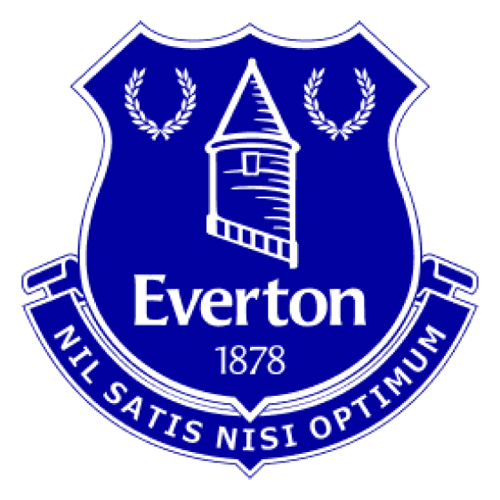 13. Everton
13. Everton
– Last season’s finish: 15th (48 points without deductions, minus-11 goal differential)
– Key ins: CB Jake O’Brien (Lyon, €19.5m), CF Iliman Ndiaye (Marseille, €18m), CM Tim Iroegbunam (Aston Villa, €10.7m), AM Jesper Lindstrom (Napoli, loan)
– Key outs: DM Amadou Onana (Aston Villa, €59.35), CB Ben Godfrey (Atalanta, €12m), LB Lewis Dobbin (Aston Villa, €11.8), CM André Gomes (contract expired), AM Dele Alli (contract expired)
Key stat
Over the past two seasons combined, Everton have underperformed their xG total by 27.2. That’s by far the largest negative gap of any team in Europe’s Big Five leagues. And in the Premier League, their underperformance has been more than twice as bad as Brighton’s second-worst mark of 12.1.
One big question: Have Sean Dyche’s debts to the dark lord finally come due?
For years, Dyche’s Burnley teams would make nerds like me bang our heads against our Cheeto-dusted keyboards in our parents’ windowless basements. “They cannot continue to concede this many quality shots,” we’d shout. It’s simply unsustainable for a team to cede such a large proportion of chances to their opponents like this. And then Burnley would, simply, continue to cede a large proportion of chances to their opponents and do something like, say, finish seventh in the Premier League.
Eventually, it became clear that Dyche’s teams were doing something that xG models couldn’t pick up on. They always had a ton of players behind the ball, and early xG models were not able to account for player positioning, so Burnley would concede fewer goals than their xG totals suggested. Once the models got better, Dyche’s teams became less mysterious. But now, it’s happening again — just in the opposite direction.
All of Dyche’s opponents are doing to his team what he did to them for years. It seems impossible that Everton will continue to miss as many chances as they have over the past two seasons, and if it is, the Toffees should cruise to a comfortable midtable finish. But on the other hand, Dyche has already proved it: sometimes there’s a team out there that does things so differently from everyone else that none of our fancy numbers or algorithms is able to pick up on it. — O’Hanlon
 14. Nottingham Forest
14. Nottingham Forest
– Last season’s finish: 17th (36 points without deductions, minus-18 goal differential)
– Key ins: CM Elliot Anderson (Newcastle, €41.2m), CB Nikola Milenkovic (Fiorentina, €14.3m), LW Jota Silva (Vitoria Guimaraes, €7m), DM Marko Stamenic (Crvena Zvezda, €5.5m), GK Carlos Miguel (Corinthians, €4m)
– Key outs: CB Moussa Niakhate (Lyon, €31.9m), GK Odisseas Vlachodimos (Newcastle, €23.6m), CM Orel Mangala (Lyon, €23.4m), CM Remo Freuler (Bologna, €4.5m)
Key stat
After Nuno Espirito Santo’s hire on Dec. 20, Nottingham Forest ranked first in xG differential on counterattacks and fifth in overall xG differential. But between a point deduction and appalling goalkeeping, they spent most of the season in the relegation fight.
One big question: Have their goalkeeping issues finally been fixed?
Under Espirito Santo, Forest ranked just 17th in possession rate and 19th in total touches, but they countered well and created better opportunities than they allowed for the most part. And it almost didn’t matter because their goalkeepers forgot how to keep goal.
Matt Turner, Matz Sels and Vlachodimos combined to face 176 shots on goal, and they were worth 47.9 post-shot xG; those shots turned into 65 goals, over 17 more than expected. No other Premier League club gave up over 10 goals beyond expectation. This was almost unsustainably bad, but Forest brought in Corinthians’ 6-foot-8 Miguel as another option.
With sturdy midfield additions and an attack built around veteran Chris Wood, Morgan Gibbs-White, Anthony Elanga and, perhaps, a finally healthy Taiwo Awoniyi, Forest should have the personnel to execute Espirito Santo’s vision again. And maybe they’ll stop some shots this time, too. — Connelly
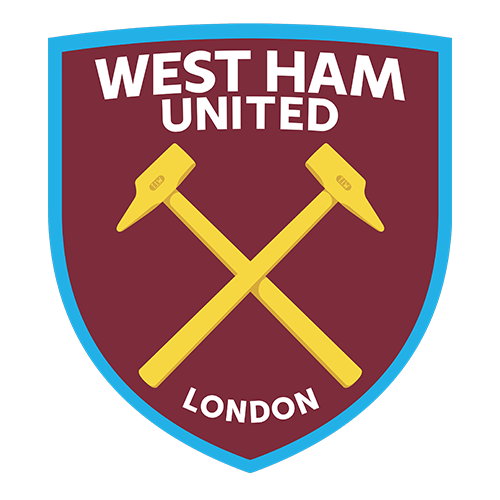 15. West Ham United
15. West Ham United
– Last season’s finish: 9th (52 points, minus-14 goal differential)
– Key ins: CB Max Kilman (Wolves, €47.5m), LW Crysencio Summerville (Leeds United, €29.3m), CF Niclas Füllkrug (Borussia Dortmund, €27.0m), RB Aaron Wan-Bissaka (Manchester United, €17.6m), RW Luis Guilherme (Palmeiras, €23.0m), DM Guido Rodríguez (Real Betis, free), GK Wes Foderingham (Sheffield United, free), CB Jean-Clair Todibo (Nice, loan)
– Key outs: DM Flynn Downes (Southampton, €17.9m), LW Saïd Benrahma (Lyon, €14.4m), CB Thilo Kehrer (Monaco, €11m), RB Ben Johnson (Ipswich Town, free)
Key stat
West Ham were 17th in goals allowed and 18th in xG allowed last season. And when they lost, they lost badly: they were outscored 49-11 in 14 defeats and lost six matches by three or more goals. And yet, David Moyes’ direct style manufactured enough wins to assure midtable safety. Now Moyes hands the controls of a very strange machine over to Julen Lopetegui.
One big question: What exactly is the plan here?
Lopetegui suffered diminishing returns at Sevilla and never got much footing in one season with Wolves, but you can see the logic of replacing Moyes with another guy who stresses defensive structure (not allowing good shots) and danger prevention (minimal high turnovers).
But West Ham’s transfer work this summer has been confusing. They seemingly overpaid by a dramatic margin for Kilman (whom Lopetegui must have loved in Wolverhampton) and perhaps Fullkrug as well. The 31-year-old is a sturdy, physical forward with underrated passing ability, but both the transfer fee and the four-year contract were a bit much. Lopetegui’s roster will be a mix of past-their-prime and not-yet-there pieces. Bowen and Mohammed Kudus still provide attacking upside, but is that enough? — Connelly
 16. Fulham
16. Fulham
– Last season’s finish: 13th (47 points, minus-6 goal differential)
– Key ins: AM Emile Smith Rowe (Arsenal, €31.8m), CB Jorge Cuenca (Villarreal, €6.7m), LB Ryan Sessegnon (Tottenham, free)
– Key outs: DM João Palhinha (Bayern Munich, €51m), CB Tosin Adarabioyo (Chelsea, free), Bobby De Cordova-Reid (Leicester City, free), Tim Ream (Charlotte FC, free), Willian (contract expired)
Key stat
With an average age weighted by minutes played of 28.4 last season, Fulham were the oldest team in the Premier League. Only seven other clubs across Europe’s Big Five leagues rolled out an older average roster on a weekly basis.
One big question: Can they turn the team over without dipping into a relegation battle?
Although the final league positions have been fine, Fulham have churned out two consecutive seasons with quite poor underlying numbers (a combined minus-29.4 xG differential). A below-average team of old players is one that inevitably gets dragged down into a relegation fight. They finally avoided the relegation-promotion yo-yo, but the approach wasn’t sustainable.
So far this summer, they moved Palhinha on for a huge fee right as he was exiting his prime years, and they’ve also let 30-something stalwarts Ream, De Cordova-Reid and Willian see out their contracts. (There’s a chance Willian could sign a new deal, but it doesn’t seem likely.) In Palhinha, Ream, De Cordova-Reid and Willian, they’ve lost 7,600 minutes from last season’s team. Throw in Adarabioyo, and it’s nearly 10,000 minutes that need replacing. Cuenca played fewer than 2,000 minutes last season, while Smith Rowe has never played 2,000 minutes in a season and has barely played in two years. Same story with Sessegnon.
Fulham have gotten younger, but have they gotten better? — O’Hanlon
James Olley assesses Emile Smith Rowe’s proposed transfer to Fulham from Arsenal.
 17. Wolverhampton Wanderers
17. Wolverhampton Wanderers
– Last season’s finish: 14th (46 points, minus-15 goal differential)
– Key ins: RM Rodrigo Gomes (Braga, €15m), RB Pedro Lima (Sport Recife, €10m), CM Tommy Doyle (Manchester City, €15m), CF Jørgen Strand Larsen (Celta Vigo, loan)
– Key outs: RW Pedro Neto (Chelsea, €60m), CB Max Kilman (West Ham, €47,5m), LB Hugo Bueno (Feyenoord, loan)
Key stat
Only two Wolves players scored more than four goals last season; both Matheus Cunha and Hwang Hee-chan had 12. The 25-year-old and 28-year-old each played more than 2,000 minutes. Why is that notable? Before last year, they’d combined for one total 2,000-minute season across their professional careers.
One big question: What are they doing?
This was the worst non-relegated team in the league last season — both by xG and by the blend of xG and goals. Hot finishing from both Cunha and Hwang, combined with a bunch of one-goal wins, made Wolves seem more competitive than they really were. I wouldn’t expect either of those things to continue into next season.
Maybe someone should tell Wolves about this? Rather than recognizing the warning signs from last season, they’ve moved on from two of their best players, Neto and Kilman. In a vacuum, these were both fantastic deals for Wolves — a massive return for a 27-year-old defender and a winger who can’t stay healthy. But as of now, their only incomings are the same type they always have: young Brazilian and Portuguese guys you’ve never heard of who will probably never make an impact for the club. Unless, somehow, both Neto and Kilman were actively making Wolves worse, why should we expect things to get any better next season? — O’Hanlon
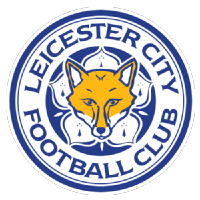 18T. Leicester City
18T. Leicester City
– Last season’s finish: 1st in the Championship (97 points, plus-48 goal differential)
– Key ins: RW Fatawu Issahaku (Sporting CP, €17m), CB Caleb Okoli (Atalanta, €14m), CM Michael Golding (Chelsea, €5.9m), RW Bobby De Cordova-Reid (Fulham, free), AM Facundo Buonanotte (Brighton, loan)
– Key outs: CM Kiernan Dewsbury-Hall (Chelsea, €35.4m), CF Kelechi Iheanacho (Sevilla, free)
Key stat
The most important stat for Leicester City this year is a point total. More specifically, the deduction they might be facing — supposedly in the realm of 12 points or so — after the Premier League referred them to an independent commission last spring for alleged breaches of profit and sustainability rules. It hovered over their push for promotion from the second division, and it looms over their Premier League return. Quite the modern Premier League story, isn’t it?
One big question: Have the Foxes lost too much?
After an unlucky relegation in 2022-23 — they were 13th in xG differential but suffered 12 one-goal losses and finished 18th — Leicester spent much of last season on a record-setting pace. They led the league by 12 points as of Feb. 14 but ended up avoiding the promotion playoff by just three points. Then they lost Iheanacho and the homegrown Dewsbury-Hall (plus manager Enzo Maresca), a year after losing James Maddison, Harvey Barnes and other key players from healthier Premier League days.
Can new manager Steve Cooper, holdover midfielders Wilfred Ndidi and Harry Winks, a 37-year-old Jamie Vardy and some newer, younger faces keep the Foxes up this time? It will probably be impossible if the point deduction comes to pass. — Connelly
 18T. Ipswich Town
18T. Ipswich Town
– Last season’s finish: 2nd in the Championship (96 points, plus-35 goal differential)
– Key ins: RW Omari Hutchinson (Chelsea, €23.5m), CB Jacob Greaves (Hull City, €21.5m), CF Liam Delap (Manchester City, €17.9m), GK Arijanet Muric (Burnley, €9.6m)
– Key outs: GK Vaclav Hladky (Burnley, free)
Key stat
Ipswich ranked first in the Championship in goals (92), assists (64) and ball recoveries (2,395). They pressed, they attacked, they snapped off shots at first sight of goal, and they held onto manager Kieran McKenna and most of last year’s key players.
One big question: Can you survive relegation with optimism?
If you’re looking for new Premier League underdogs to adopt, Ipswich check a lot of boxes. One of the league’s original teams (and a club with 62 continental matches on their resume), they haven’t been back up in the top division since 2002 and they were in the third division as recently as May 2023.
But they rode a swashbuckling attacking style to two straight promotions, and now they hope the same active roster core — string-pulling No. 10 Conor Chaplin (13 goals, 8 assists), assists master Leif Davis (18 assists), loose-ball specialist Sam Morsy (first in the league in ball recoveries), et al. — can exceed expectations as much as they did last year. It wouldn’t be unheard of, but after all three promoted teams immediately went back down last season, it looks like the mountain to climb is getting steeper. — Connelly
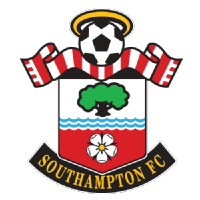 20. Southampton
20. Southampton
– Last season’s finish: 4th in the Championship (87 points, plus-24 goal differential)
– Key ins: CB Taylor Harwood-Bellis (Manchester City, €23m), DM Flynn Downes (West Ham, €17.85m), LW Ben Brereton Díaz (Villarreal, €8.3m), RB Yukinari Sugiwara (AZ Alkmaar, €7m), CB Nathan Wood (Swansea, €3.5m), CB Ronnie Edwards (Peterborough, €3.5m), LB Wellington (Sao Paulo, free), LB Charlie Taylor (Burnley, free), CF Juan (Sao Paulo, free), CF Rento Takaoka (Nissho Gakuen, free), CM Kuryu Matsuki (FC Tokyo, unreported)
– Key outs: CB Lyanco (Atletico Mineiro, €4.5m), CB Duje Caleta-Car (Lyon, €3.59m), LB Romain Perraud (Real Betis, €3.5m), Ché Adams (Torino, fee transfer), CM Stuart Armstrong (contract expired)
Key stat
One of rules of thumb for handicapping the newly promoted teams is that the best defensive sides tend to stay up. If you defend well in the Championship, that will still frequently translate to the Premier League, where you’ll have to do even more defending. The teams that dominate with the ball, though, tend to struggle once they’re promoted because almost every other team they play suddenly has more talent than they do. Last season, Southampton conceded 64 goals, the 14th-best mark in the Championship.
One big question: Can the long-term plan work right now?
Since the new ownership group — Sport Republic, led by Rasmus Ankersen, formerly of Brentford and FC Midtjylland — took over in 2022, Southampton have clearly had a plan. That plan, essentially: use some form of data scouting to acquire a ton of low-fee youngsters from across the world. What to actually do with those youngsters, though, is another question.
This summer, Southampton brought in players from the Champions League, Championship, Premier League, League One, LaLiga, the Dutch Eredivisie, the Campeonato Brasileiro, the Japanese Pro League and the Japanese high school system. Many of these guys won’t arrive until midseason or next year, and some of them are or will be loaned out to Sport Republic’s club in Turkey, Goztepe.
These guys are certainly doing interesting things — looking in places other clubs don’t look, agreeing to unique deal structures, using their multiclub structure. For now, though, it’s hard to see how it all adds up to a competitive Premier League team. — O’Hanlon



